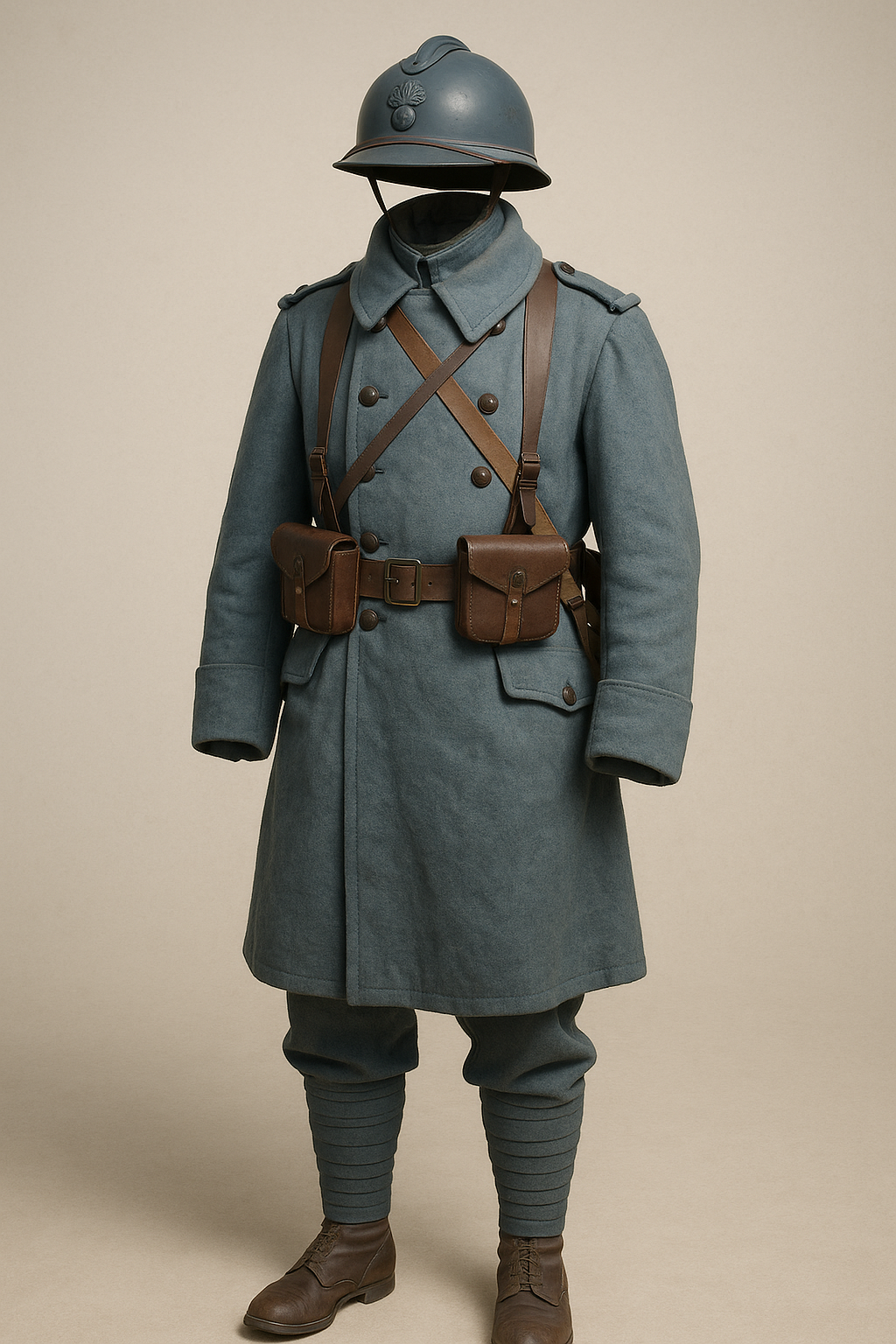
French WW1 Uniform: A Beginner’s Guide to the Iconic Blue Battle Dress
Published on Aug 31, 2025
French WW1 Uniform: A Beginner’s Guide to the Iconic Blue Battle Dress
Why were French WW1 uniforms blue, even in a war dominated by mud and camouflage?
It’s a question that surprises many new students of military history. When most nations in World War I adopted muted tones for concealment, the French stuck with bright horizon blue for much of the war—a decision rooted in tradition, politics, and practicality.
Whether you're a history enthusiast, reenactment, or collector, understanding the French WW1 uniform opens up a fascinating window into the early 20th-century battlefield. This guide covers the uniform's evolution, key features, and how to start collecting or identifying authentic pieces.
The Origins of the French WW1 Uniform
Before the Great War, French soldiers wore vibrant red trousers and navy-blue coats, reminiscent of Napoleonic and 19th-century styles. These were the "pan talon rouge" uniforms that made French troops stand out—sometimes too much.
When World War I broke out in 1914, French forces entered battle with these outdated uniforms, resulting in high casualties. The vivid red trousers were easy targets in modern trench warfare.
Why Were French WW1 Uniforms Blue?
In late 1914, the French army introduced the “horizon blue” uniform to improve camouflage and reduce visibility on the battlefield. This blue-grey tone was:
- More practical for muddy trenches.
- Easier and cheaper to mass-produce.
- Symbolically distinct from enemy colours.
Interestingly, the horizon blue was chosen not just for functionality but also to maintain national pride and identity, avoiding the dull German Feldgrau (field grey).
Key Features of the French WW1 Uniform
The French uniform WW1 soldiers wore from 1915 onward had standardised features:
H2: Standard Components of a French WW1 Uniform
- Horizon Blue Greatcoat (Capote Mle 1914): Thick wool, double-breasted, calf-length.
- Adrian Helmet (M15): One of the first steel helmets in WW1; replaced the soft kepi.
- Tunic (vareuse): Shorter wool coat under the greatcoat.
- Trousers (Pan talon Mle 1914): Baggy design, made from the same blue-grey wool.
- Puttees and Boots: Leg wraps and leather ankle boots.
These elements gave the WW1 French uniforms their iconic look, balancing visibility, warmth, and tradition.
H2: How to Collect French WW1 Uniforms – A Starter Guide
Collecting WW1 military is a rewarding hobby—but requires caution. Here's how to get started with French WW1 uniforms:
H3: Step 1 – Learn to Spot Originals vs. Reproductions
Original pieces are rare, and the market is full of reproductions. Look for:
- Authentic stitching (often hand-sewn or chain-stitched).
- Manufacturer’s markings with dates (usually inside the tunic or capote).
- Age-appropriate materials (e.g., real wool vs. synthetic blends).
H3: Step 2 – Start with Easier-to-Find Pieces
- Adrian Helmets are more common and easier to verify.
- Puttees and gear straps are affordable starter items.
- Avoid early war red trousers unless well-verified—they’re rarer and more faked.
H3: Step 3 – Build a Network
Connect with:
- WW1 reenactment groups.
- Forums like Great War Forum or Military Collectors.
- Local antique dealers or military shows.
H2: Common Pitfalls When Researching or Buying French WW1 Uniforms
Many beginners fall into traps when diving into the world of WW1 French uniforms:
H3: 1. Confusing WW1 and WW2 French Gear
WW2 uniforms were olive or khaki. WW1 uniforms used horizon blue—don’t mix them up.
H3: 2. Misidentifying Reenactment Uniforms as Originals
Modern reenactment gear is high-quality but usually:
- Made with modern dyes.
- Uses updated sizing or zippers (WW1 uniforms had none).
H3: 3. Overpaying for Poor Condition Items
Even genuine WW1 items should be evaluated for:
- Moth damage (common in wool).
- Rust on buttons or helmet liners.
- Missing parts (original chinstraps or epaulettes can be rare).
H2: French WW1 Uniforms in Modern Reenactment and Media
There’s a growing trend in reenactment communities and film productions to accurately portray WW1 uniforms.
Why This Matters:
- Increased interest = higher prices for authentic gear.
- Reenactment groups often set the standard for authenticity.
- Museums and indie filmmakers seek accurate costumes.
If you’re involved in reenactments, consider high-end reproductions that mimic original specs (e.g., wool weight, button type, stitching style). This ensures a close look without risking valuable antiques.
H2: Actionable Tips for Beginners Interested in French WW1 Uniforms
Here’s how to dive deeper into the world of French WW1 uniforms with confidence:
- Read military history books focused on uniform design.
- Use visual guides (like Osprey’s “Men-at-Arms” series).
- Visit military museums with WW1 exhibits.
- Join online communities for daily tips and photos.
- Watch documentaries or films with well-researched costumes (e.g., 1917, J'accuse).
Conclusion: The Legacy of the French WW1 Uniform Lives On
The French WW1 uniform isn’t just a relic of the past—it’s a symbol of a nation's resilience, identity, and adaptation in one of history’s most brutal wars. Its transformation from flamboyant reds to horizon blue practicality tells a story of battlefield evolution and national pride.
Whether you’re collecting, studying, or reenacting, remember:
- Start simple.
- Learn continuously.
- Avoid shortcuts when verifying authenticity.
